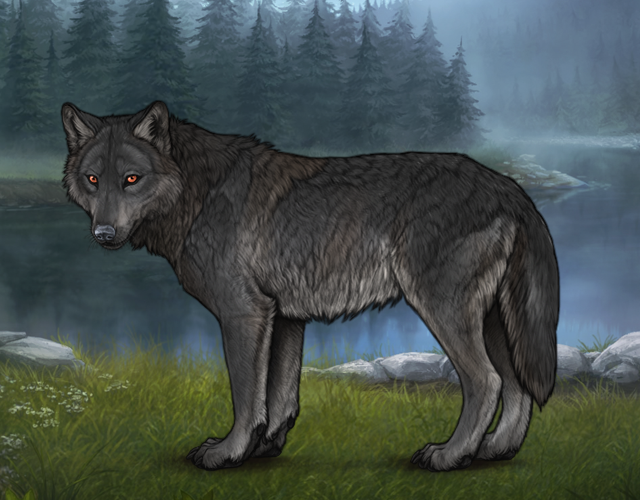ID #6828212
This wolf has not rolled over today and will not be able to be traded or gifted until its next rollover.

| Currents | |
|---|---|
| Age | 5 years 5½ months (Adult) |
| Sex | Female |
| Energy |
|
| Mood |
|
| Hunger |
|
| HP |
|
| Personality | Selfish |
| Breeding Information | |
|---|---|
| Age in Rollovers | 131 |
| Pups Bred | 9 pups bred |
| Last Bred | 2024-12-31 04:22:07 |
| Fertility | Very Good |
| Heat Cycle |
In heat for 4 rollovers |
| Items Applied | None! |
| Pair Bond |
None
|
| Looks | |
|---|---|
| Base | Slate (0.19%) |
| Base Genetics | Monochrome Dark III |
| Eyes | Orange |
| Skin | Black |
| Nose | Blue |
| Claws | Black |
| Mutation | None |
| Secondary Mutation | None |
| Carrier Status | Unknown |
| Variant | Default |
| Markings
|
|
|---|---|
| Slot 1 | None |
| Slot 2 | None |
| Slot 3 | None |
| Slot 4 | None |
| Slot 5 | None |
| Slot 6 | None |
| Slot 7 | None |
| Slot 8 | None |
| Slot 9 | Dinar Undercoat (14% : T6) |
| Slot 10 | None |
Biography
About the Star
Epsilon Crucis is an orange giant, a class K3III star with a visual magnitude of 3.56, approximately 228 light years distant from Earth. The star is also represented on the flag of Brazil: it represents the State of Espírito Santo.
Crux myth
Crux is a famous constellation in many cultures. Ancient Greeks considered it to be part of the Centaurus constellation. Greeks were able to see Crux before its stars dropped below the horizon for Europe and most of the northern hemisphere. Some saw significance in this, linking the disappearance of the celestial cross from the sky to the crucifixion of Christ. The 2nd century Greek astronomer Ptolemy listed the stars of Crux as part of the constellation Centaurus in his Almagest. By the year 400 AD, the constellation was not visible from most of Europe anymore, and Europeans did not rediscover Crux until the great naval expeditions of the late 15th and early 16th century.
The Southern Cross carries cultural significance in many countries in the southern hemisphere.
A stone image of Crux constellation has been found in Machu Picchu in Peru. The Inca knew the constellation as Chakana, which means "the stair." The Maori called it Te Punga, or "the anchor."
In Australian Aboriginal astronomy, the cross asterism and the Coalsack Nebula represent the head of the Emu in the Sky. The Southern Cross is represented on the Australian flag. Its stars are also featured on the flag of Brazil, where the asterism is known as Cruzeiro, or Cruzeiro do Sul. The Southern Cross is also mentioned in the Brazilian national anthem and used to be the name of the currency between 1942 and 1986 and again between 1990 and 1994.
Amerigo Vespucci charted the stars in 1501, but a more accurate depiction appeared in 1515, made by another Italian explorer, Andrea Corsali. Crux appeared on celestial globes by Petrus Plancius (1598) and Jodocus Hondius (1600). Plancius, a Dutch cartographer, depicted the constellation based on observations by Pieter Dirkszoon, a Dutch explorer.
Crux myth
The Southern Cross carries cultural significance in many countries in the southern hemisphere.
A stone image of Crux constellation has been found in Machu Picchu in Peru. The Inca knew the constellation as Chakana, which means "the stair." The Maori called it Te Punga, or "the anchor."
In Australian Aboriginal astronomy, the cross asterism and the Coalsack Nebula represent the head of the Emu in the Sky. The Southern Cross is represented on the Australian flag. Its stars are also featured on the flag of Brazil, where the asterism is known as Cruzeiro, or Cruzeiro do Sul. The Southern Cross is also mentioned in the Brazilian national anthem and used to be the name of the currency between 1942 and 1986 and again between 1990 and 1994.
Amerigo Vespucci charted the stars in 1501, but a more accurate depiction appeared in 1515, made by another Italian explorer, Andrea Corsali. Crux appeared on celestial globes by Petrus Plancius (1598) and Jodocus Hondius (1600). Plancius, a Dutch cartographer, depicted the constellation based on observations by Pieter Dirkszoon, a Dutch explorer.
| Birth Stats | ||
|---|---|---|
| Strength | Speed | Agility |
| 50 | 47 | 43 |
| Wisdom | Smarts | Total |
| 50 | 44 | 234 |
| Birth Information | |
|---|---|
| Moon | |
| Season | |
| Biome | Deciduous Forest |
| Decorations and Background |
|---|
Background
None equippedDecorations
Above
None equipped!
Below
None equipped!
Currently
 Pupsitter
Pupsitter
| Proficiency | |
|---|---|
| Hunting: Stalking | |
| Hunting: Chasing | |
| Hunting: Finishing | |
| Scouting | |
| Herbalism | |
| Pupsitting | |
| Statistic | Count |
|---|---|
| Total Number of Scouts | 0 |
| Total Number of Hunts | 1 |
| Successful Hunts | 0 |
| Total Number of Lessons Taught | 0 |
| Pupsitting Information | |
|---|---|
| Pupsitting Proficiency |
|
| Total Protection | 90% |
In current pack for 105 rollovers
Wolf created on 2023-02-12 08:00:32